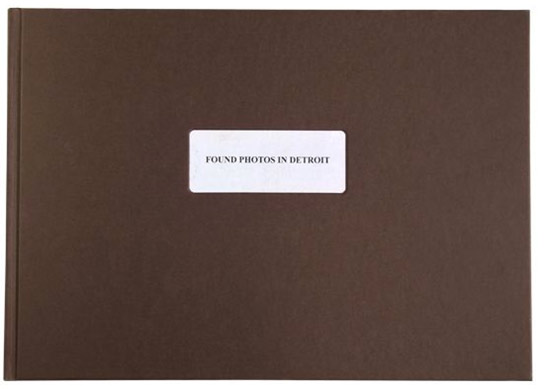Review: Found Photos in Detroit

I have been thinking about Found Photos in Detroit for a long time now, wondering whether or not to write a review. The book combines two tropes that have been very popular over the past few years, photography in Detroit and found/discarded photographs. Photography in Detroit, which for the most part has centered on photographs of abandoned buildings (“ruin porn”), usually does not show people. In contrast, projects around found photographs typically focus on people. And we’ve seen attempts like this one before, for example when found photographs from New Orleans or the areas hit by last year’s earthquake/tsunami in Japan were displayed. But still… I suppose my hesitation really comes down to the fact that I have no idea what Found Photos in Detroit is actually trying to tell me. (more)
At 16.5 x 11.7 in / 42 x 29,7 cm, the book is a rather large affair, which often crams too many photographs into a single spread. The book is designed to look like a scrap book or album of sorts, but it doesn’t necessarily come across as such. This is too bad, since many of the found photographs are very touching.
Detroit was not hit by any natural disaster. Life did not suddenly stop here for very large numbers of people. Instead, Detroit is an American city like many others. I have a local Detroit right at my doorsteps. Twenty minutes down the road from here lies Holyoke, MA. Or I could drive out west for three or four hours and hit the rust belt in upstate New York. OK, Detroit at some stage was the center of American car making. But Holyoke at some stage was the center of American paper making, and Pittsburgh, where I lived for five years, was the center of American steel. No natural disaster turned any of those cities into what they are now. Instead, their decay (and struggle to re-emerge) is entirely man-made. On top of that, you need to throw in all the other ingredients of American life that have affected different races or classes in different ways, and you end up with a pretty complex picture.
So again, what exactly is Found Photos in Detroit telling me? A few years ago, Alec Soth wrote about how he was missing the people in photographs from New Orleans (for which, predictably, he got into trouble with some of the photographers he was not even criticizing - see this post). Taking photographs found in Detroit adds people to the picture, at least in some sense. But found photographs complicate the issue of authorship, and that is the main problem here. If you want to show me people in Detroit, please go to people and photograph them!
When you use photographs found in the streets, you’re appropriating something that was created for very different purposes. There is a complex power dynamic going on when working with photographs found in the street (or bought off Ebay - which is something I do all the time). If you find someone’s photograph that person has no power whatsoever over what you are going to do with it. Power, however, or a lack of power, seems like a crucial aspect for a topic like Detroit: How could so many people’s lives be ruined, in such plain view, over such a long period of time?
Because Detroit is such a large topic, because there is no clear disaster going on, no waves hitting the shores and wiping out homes, showing found photographs from Detroit adds about as much to the topic as photographing empty buildings: Each viewer will come to their own, very different conclusions about American capitalism, our society, race relations, poverty, a lack of decent health care, etc. etc. etc. Given the vastness of the subject matter that is attached to the word Detroit, showing photographs found in the city’s streets runs the risk of dissipating their energy, which, I fear, has happened here. Instead of the ruins of buildings, we here have the ruins of photographs, torn, scratched, ruined by water.
Found Photos in Detroit; collected, edited and designed by Arianna Arcara & Luca Santese; 80 pages; Cesura; 2012